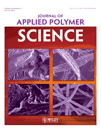Grafting hydroxy-terminated polybutadiene onto nanosilica surface for styrene butadiene rubber compounds
Abstract
Hydroxy teminated polybutadiene (HTPB) was grafted onto the surface of nanosilica particles via toluene di-isocyanate (TDI) bridging to reduce filler–filler interactions and improve dispersion of nanosilica in rubber. Also, this prepolymer as modifier contains double bonds which participate in sulfur curing of styrene butadiene rubber (SBR) matrix to enhance filler/polymer interaction and reinforcement effects of silica. The reactions were characterized by titration and Fourier transforms infrared spectroscopy. Thermogravimetric analysis was utilized to evaluate the weight percentage of grafted TDI and HTPB. About 60% of the hydroxyl sites of silica were reacted with excess TDI in the first reaction. In the second reaction, HTPB as desired reactive coating was grafted on the functionalized nanosilica to constitute about 24 wt % of the final modified silica. The sedimentation experiments showed good suspension stability for the modified nanosilica in the organic media. Scanning electron microscopy revealed nanoscale dispersion of modified silica aggregates in the SBR matrix at concentration of about 14 phr. Also, vulcanization characteristics and mechanical properties of compounds demonstrated that HTPB grafting improved dispersion of nanosilica as well as its interaction to the rubber matrix as an efficient reinforcement. © 2011 Wiley Periodicals, Inc. J Appl Polym Sci, 2011




